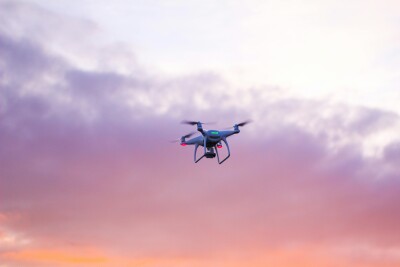The advantages and opportunities that thermal imagery provides are incredible to consider, especially since that information can be gathered so quickly and easily via a drone. We’ve explored what kind of value can be created with the combination of thermal and multispectral imagery in one drone flight, and that thermal piece is being enabled by FLIR Systems technology. Their innovative sensing solutions have essentially created a sixth sense for users that continue to change expectations for a variety of commercial applications.

Randall Warnas
Randall Warnas is the Global sUAS Segment Leader at FLIR, whose insights and knowledge are on regular display at
FLIR DELTA, a drone education lab for thermal applications. His experiences with drone and thermal technologies have provided him with an incredible perspective around how entire industries will be further changed by thermal capabilities in 2019, and what kind of impact that will enable for the drone industry as a whole.
Jeremiah Karpowicz: With the announcement of the DJI Mavic 2 Enterprise Dual, it seems like we’re already seeing the type of solutions that will make the adoption of thermal technology even easier in 2019. Do you think these sorts of integrations are going to be an even bigger story in 2019 than thermal technology itself?
Randall Warnas: They’ll certainly be critically important, and that’s mostly because you have to remember that thermal is a 40-year-old technology that to most people, it’s science fiction. The biggest changes we’re making are around ease of access to get this technology into more people’s hands than ever before. Integrations like you’re seeing with the Mavic 2 Enterprise Dual as well as ones we’ve created in the past like the
DJI Zenmuse XT2 are all about making things simpler and easier on user interface side. We want to encourage more people to give it a go.
Part of that is also about these products being that much more affordable and capable than ever before. A few years ago, you had to have a much larger budget to get involved in the technology. Prices have come down in a major way since then, especially with the Lepton, which is what is in our FLIR ONE mobile accessory.
We’re also now starting to use our VGA
Boson camera core, which is smaller than the predecessor Tau 2 for various reasons including that the thermal sensor pixel is smaller. So as we create new products based around the Boson, we're going to reduce power input, size and weight which all have a dramatic effect on flight capacity. That’s going to enable these products to be more easily integrated into a variety of different aerial platforms. Versatility is really where we're seeing our biggest opportunities in 2019.
What sort of impact do you expect that versatility will enable in for operators when it comes to especially creative approaches with the technology in 2019?Thermal imaging technology is not something people are interacting with on a regular basis, but once someone sees what it can add to drone applications in the workplace, there’s a lot of enlightenment that happens. When you're able to see heat you can think about a given task or requirement in a whole new way. We see creative applications all the time, many of which have been enabled thanks to someone getting their hands on our product.
I know there's a group in the Czech Republic that's using our products to look for problems with their underground heating mechanisms which run under the roads to keep ice from forming on streets. They're charged with inspecting the entire infrastructure of these systems, and they couldn’t have easily done that without our thermal sensors. That’s just one example, but when you see how compelling this imagery is, it really gets people thinking. From there, all it takes is a "maybe I should try this" idea to literally change the way they're going to do things going forward.
You work with a number of public safety officials, including fire departments and police officers. I’ve heard that their biggest challenge with the adoption of drone technology is around the public perception of their use of the technology, so I’m wondering if you’ve seen that change or think it will further evolve in 2019. I have seen that change, and much of it is due to one of the greatest shifts we’ve seen within the drone industry as a whole. It’s taken some time, but we now, finally, have large enterprises and public safety entities being vocal about how they're using the technology.
Drone technology has had the reputation of being a bit taboo, and there was often a serious caution around how an enterprise or department would promote what they were doing. I think we’re rounding that corner, and people really want to take credit for the incredible things they're doing with this technology. I think we'll see more of the people that have been using thermal imaging drones out there in 2019 talking about the efficiencies they’re creating and the safety savings they’re seeing. The fear of competition or public pushback is becoming less and less.
That’s really important, because we’re all waiting for the industry to get some validation to the point that it's a no-brainer and we aren't fighting the same battles with the FAA or public opinion. That willingness to showcase what adoption looks like is in part driven by the versatility and power of the integrations we talked about earlier, and that’s why I think 2019 is going to be a year of finding out who is really here to stay in this industry.
2018 obviously provided us with a few examples of companies who aren’t in this industry to stay, with Airware being the biggest one. That has and still does cause some people to be nervous about where this industry is headed, but do you think the further consolidations we’ll undoubtedly see in 2019 should be a cause for concern? When the news about Airware came out there were a lot of people that put on their panic hat and figured there must be others as well, but that’s really not what we should be focused on. Yes, there will be winners and losers in this space, but those that are willing to collaborate and open their doors to possibilities are going to stick around.
For those that truly have something to offer to the industry, sticking it out is going to be worth it, and we haven't hit even the tip of the iceberg on this. It's still early days, and I'm hoping that the changes in public perception and examples of where this technology is already making a difference will help move things along in a big way in 2019. Shakeups and shakeout are going to happen, but our focus should be on encouraging positive changes to FAA regulation as well as getting everyone on the same page so we can work together to collaborate and use drones responsibly.
Lastly, any hints you can offer about upcoming guests on or developments in 2019 on FLIR DELTA? We're hoping to attract different leaders within the drone industry to talk about their personal journeys and their interests. The goal there is really to just build a community around drone stakeholders, regardless of whether they're working with thermal industry or not, or whether they're on the consumer side or the industrial side. We want to bring everyone into a single place where we can talk about this technology and how these spaces are changes, because there are so many lessons to be learned about taking risks, managing risks, effectively collaborating and how you interact with an industry.
Specifically, we're set to have multiple conversations with our partners from MicaSense and SlantRange on the multi-spectral side, but also with DJI, Yuneec and Intel on the airframe side. We’re also going to be talking with high-end users from LAFD, NYPD and a few other entities that are using the technology at a high level.

















Comments